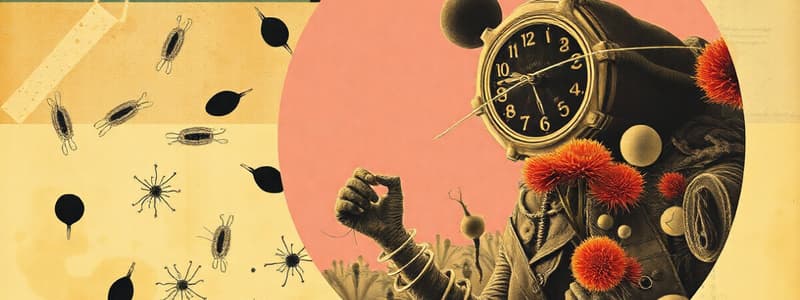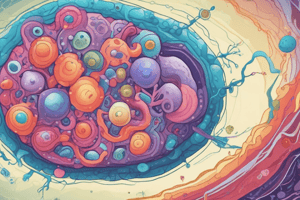Podcast
Questions and Answers
What is the primary purpose of the condenser in a microscope?
What is the primary purpose of the condenser in a microscope?
- To focus light onto the slide (correct)
- To illuminate the slide
- To hold the objective lenses
- To magnify the specimen
Which part of the microscope is responsible for holding the slide in place?
Which part of the microscope is responsible for holding the slide in place?
- Nosepiece
- Stage
- Stage Clips (correct)
- Illuminator
What should you do first when focusing on a specimen using a microscope?
What should you do first when focusing on a specimen using a microscope?
- Adjust the diaphragm
- Use the fine focus knob
- Switch to a higher power objective lens
- Use the coarse focus knob (correct)
Which microscope component is adjusted to control light intensity reaching the slide?
Which microscope component is adjusted to control light intensity reaching the slide?
What is the role of the objective lenses in a microscope?
What is the role of the objective lenses in a microscope?
What is the function of the fine focus knob?
What is the function of the fine focus knob?
Which part of the microscope should be held when carrying it?
Which part of the microscope should be held when carrying it?
What is the characteristic feature of the objective lenses used in microscopes?
What is the characteristic feature of the objective lenses used in microscopes?
How should the slide be positioned on the stage?
How should the slide be positioned on the stage?
What happens when you switch from a lower to a higher power objective lens?
What happens when you switch from a lower to a higher power objective lens?
Which of the following organelles is specifically found in plant cells and plays a crucial role in photosynthesis?
Which of the following organelles is specifically found in plant cells and plays a crucial role in photosynthesis?
What is a key difference between prokaryotic and eukaryotic cells regarding their genetic material?
What is a key difference between prokaryotic and eukaryotic cells regarding their genetic material?
Which part of the cell serves as the control center that holds DNA?
Which part of the cell serves as the control center that holds DNA?
Which type of microscope is best suited for viewing the internal structures of very small cells?
Which type of microscope is best suited for viewing the internal structures of very small cells?
What structural feature distinguishes animal cells from plant cells?
What structural feature distinguishes animal cells from plant cells?
In which part of the cell would you find a large vacuole and what is its primary function?
In which part of the cell would you find a large vacuole and what is its primary function?
What characteristic of prokaryotic cells contributes to their generally smaller size compared to eukaryotic cells?
What characteristic of prokaryotic cells contributes to their generally smaller size compared to eukaryotic cells?
Which component of the microscope is essential for magnifying the specimen being viewed?
Which component of the microscope is essential for magnifying the specimen being viewed?
Which of the following statements about eukaryotic cells is correct?
Which of the following statements about eukaryotic cells is correct?
What is the primary function of chloroplasts in plant cells?
What is the primary function of chloroplasts in plant cells?
What is the primary distinction between eukaryotic cells and prokaryotic cells?
What is the primary distinction between eukaryotic cells and prokaryotic cells?
Which of the following statements accurately defines tissues in multicellular organisms?
Which of the following statements accurately defines tissues in multicellular organisms?
Which of the following best describes the role of organs in an organism?
Which of the following best describes the role of organs in an organism?
What defines an organ system within multicellular organisms?
What defines an organ system within multicellular organisms?
How do unicellular organisms differ from multicellular organisms?
How do unicellular organisms differ from multicellular organisms?
Which tissue type is responsible for transmitting signals throughout the body?
Which tissue type is responsible for transmitting signals throughout the body?
What is the relationship between cells, tissues, and organs in biological organization?
What is the relationship between cells, tissues, and organs in biological organization?
Which organ system includes the heart and blood vessels?
Which organ system includes the heart and blood vessels?
What is the primary function of epithelial tissue?
What is the primary function of epithelial tissue?
Which of the following describes the basic building blocks of life?
Which of the following describes the basic building blocks of life?
Flashcards are hidden until you start studying
Study Notes
Key Terms
- Cells: Fundamental units of life, making up all living organisms.
- Eukaryotes: Cells with a nucleus and organelles; examples include humans, animals, and plants.
- Prokaryotes: Simpler cells without a nucleus; bacteria are prime examples.
- DNA (Deoxyribonucleic Acid): Molecular instructions within cells governing growth and reproduction.
- Amoeba: A single-celled organism capable of movement and feeding by shape alteration.
Cell Organization
- Tissues: Groups of similar cells collaborating for specific functions (e.g., muscle and nervous tissues).
- Organs: Composed of various tissues, multitasking to perform specific operations (e.g., the heart pumps blood).
- Organ Systems: Combinations of organs working together for complex body functions (e.g., circulatory, digestive systems).
- Organisms: Living entities consisting of multiple organ systems (e.g., humans combine several systems for survival).
Cell Types Comparison
- Prokaryotic Cells: Smaller size, no true nucleus, lack membrane-bound organelles.
- Eukaryotic Cells: Larger size, possess a defined nucleus containing DNA, have membrane-bound organelles.
- Plant Cells: Include cell walls, chloroplasts (for photosynthesis), and large vacuoles.
- Animal Cells: Lack cell walls, chloroplasts, and have small vacuoles.
Cell Components and Functions
- Cell Wall: Rigid outer layer in plant cells providing structure and protection.
- Cell Membrane: Semi-permeable barrier managing nutrient and waste exchange.
- Cytoplasm: Gel-like substance within the cell where organelles float and cellular activities occur.
- Nucleus: Control center housing DNA, regulating cell functions.
- Mitochondria: Energy producers for the cell, facilitating cellular respiration.
- Chloroplasts: Organelles in plant cells that perform photosynthesis.
- Vacuoles: Storage compartments, larger in plants than in animals.
Microscopy Techniques
- Fluorescence Microscope: Utilizes special light to visualize glowing cellular components.
- Light Microscope: Employs regular light for magnified observations of cells.
- Electron Microscope: Uses electron beams for viewing extremely small structures beyond light microscope capabilities.
Microscope Components
- Eyepiece: Lens for viewing specimens.
- Objective Lenses: Magnifying lenses for different zoom levels.
- Nosepiece: Rotatable section holding objective lenses.
- Stage: Surface for slide placement.
- Stage Clips: Secure the slide in place.
- Illuminator: Light source illuminating the specimen from below.
- Condenser: Focuses light onto the slide for clarity.
- Diaphragm: Controls light intensity reaching the slide.
- Arm: Handle for microscope transportation.
- Base: Stabilizes the microscope.
- Coarse Focus Knob: Quickly adjusts stage height for initial focus.
- Fine Focus Knob: Enables precise focusing adjustments.
Using the Microscope
- Setup: Position on a stable, well-lit surface.
- Holding: Support by arm with one hand and base with the other.
- Slide Placement: Center slide under the desired objective lens using clips.
- Focusing: Start with the lowest magnification, utilizing coarse focus; switch to higher magnifications with fine focus for detail.
Studying That Suits You
Use AI to generate personalized quizzes and flashcards to suit your learning preferences.




